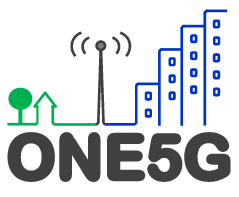E2E-aware Optimizations and advancements for the Network Edge of 5G New Radio
 The provision of a “5G Advanced” (pro) evolved air interface solution, optimized with an E2E perspective, is the focus of this project proposal called ONE5G (E2E-aware Optimizations and advancements for the Network Edge of 5G New Radio). The overall goal towards which ONE5G will strive is to design the evolution of the 5G system and build consensus in 3GPP on the proposed promising extensions beyond Release 15, in order to meet the demands of megacities and underserved areas in a performance and cost efficient manner.
The provision of a “5G Advanced” (pro) evolved air interface solution, optimized with an E2E perspective, is the focus of this project proposal called ONE5G (E2E-aware Optimizations and advancements for the Network Edge of 5G New Radio). The overall goal towards which ONE5G will strive is to design the evolution of the 5G system and build consensus in 3GPP on the proposed promising extensions beyond Release 15, in order to meet the demands of megacities and underserved areas in a performance and cost efficient manner.
As a summary, in order to realize our ambitious targets a group of major stakeholders have been gathered to collaborate in ONE5G towards the achievement of the following high level measurable objectives:
- Objective 1: To propose the necessary 5G extensions, from the performance and cost perspectives, in order to address the two selected scenarios (Megacities and Underserved Areas).
- Objective 2 : To build consensus on new features that must be considered in the various releases of 5G, and to provide technical recommendations for moving 5G towards “5G advanced”. These technology elements will solve identified issues, not yet sufficiently covered by 5G at this point in time. The ONE5G outcomes will be fed towards 3GPP in releases 16 and 17 (i.e. RAN phase 2 and phase 3 work items).
- Objective 3: To propose advanced link technologies and enhancements beyond Rel.15 to enable multi-service operation and practical implementation of” 5G advanced”, with future-proof multi-service access schemes, and advanced massive MIMO enablers and link management.
- Objective 4: To research and deliver highly generic performance optimization schemes for the 5G New Radio, in order to achieve successful deployment and operation, including optimizations for both the network operator and the E2E user-experienced performance.
- Objective 5: To identify the cost driving elements for the roll-out and operation and to propose adaptions to allow sustainable provision of wireless services in underserved areas under constrained circumstances.
- Objective 6: To validate the developed extensions and modifications through different approaches: analytically, by means of extensive simulations and with the help of proof-of-concepts for selected aspects.
- Objective 7: To produce a high number of valuable contributions to relevant conferences and the printing media (>50), a reasonable amount of IPR (>10) and partner specific standardization contributions.
Partners:
- Nokia Solutions and Networks GmbH & Co. KG (Coordinator)
- Orange SA
- Aalborg University
- B-COM
- Centre National de la Recherche Scientifique (CNRS)
- Fraunhofer Gesellschaft zur angewandten Forschung, Heinrich Hertz Institut
- Heisenberg Communications and Information Theory Group, F(reie) U(niversität) Berlin
- Huawei Technologies Duesseldorf GmbH
- Intel Deutschland GmbH
- Nokia Solutions and Networks, Denmark
- Samsung Electronics UK
- Telefónica I+D
- Universidad de Malaga
